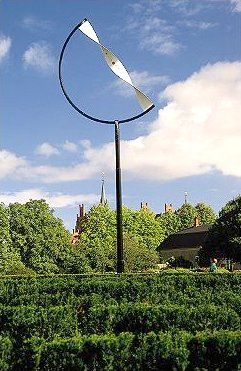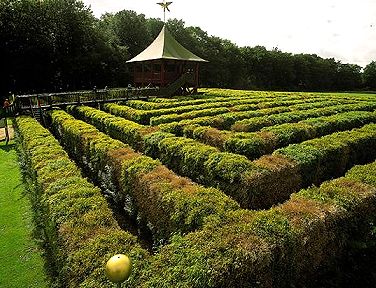
Sundials ??
Helical dial, Egeskov Castle, Kværndrup, Denmark

The dial face consists of a helical strip. Its axis points to Polaris. The edge of the strip is the gnomon, which causes a shaded area on the strip. The borderline between light and shadow indicates the time. The time scale is laid out along the center of the strip. A torsion of 15° corresponds with 1 hour on the time scale.
Designer of this unusual device is Piet Hein, a Danish physicist, puzzle inventor and writer. He even got a patent on this invention.
Advantages of this design are, according to Hein: the dial is in one piece, no separate gnomon and time scale, and it can be easily read from a distance, also from different directions.
Hein donated a dial to Egeskov, the most beautiful castle of Denmark, according to experts, located on the island of Fyn. The dial is set in the gardens, on top of a 9 m (30 ft) high pole. The strip is 1 m (over 3 ft) long. That should make an impressive sight!
The bizarre thing is: the dial doesn't work properly. At least, not always. Around the equinox, a sharp-edged shadow is cast on both sides of the strip, perpendicular to the strip's axis, and the hour marks are laid out to be in tune. Towards the solstices, the shadow boundary on one side gets oblique and fuzzy, whereas the edge on the other side shifts away from the right position. The deviation is some 25 minutes at most. John Moir observed this in a model, made from a wide elastic strip, and reported the results in the Bulletin of the British Sundial Society, nr. 95.1.
When you think about it, the improper behavior is not such a surprise. The helix can be thought to consist of straight, thin rods, connected to the longitudinal axis in the middle, each slightly twisted with respect to the neighboring rod. At the equinox, the sun is also perpendicular to the strip's axis. One rod's side is still catching the sun, whereas its neighbor doesn't anymore. The shadow is perpendicular and sharp.
Near the solstices, the sunrays are oblique with respect to the rods. On the side where the shadow remains sharp, the 'correct' rod gets in the shadow of neighboring rods. I guess the deviation also depends on the width of the strip as compared to the pitch of the helix (1:8 in Moir's model). On the other side of the strip, the rays kind of skim obliquely over a number of rods, giving am oblique, fuzzy boundary.
Piet Hein most probably was aware of this imperfection at an early stage. That may be the reason why the Egeskov dial is the only specimen in existence, as far as I know.
I never realized that a patent does not guarantee that the registered claims are correct. Thinking about that, the patent agency can not possibly test every submitted invention. Perhaps it could in the case of a dial, but certainly not for a blast furnace or a refinery. And why would they (or anyone) care? If the invention doesn't work, no one would like to 'steal' it...
Website: Egeskov Castle (select nr. 25)
Location: 55.2° N, 10.5° E
Design: Piet Hein, Denmark
Inauguration: 1989
 The gardens of Egeskov Castle also house several mazes. So I certainly should go there some time!
The gardens of Egeskov Castle also house several mazes. So I certainly should go there some time!